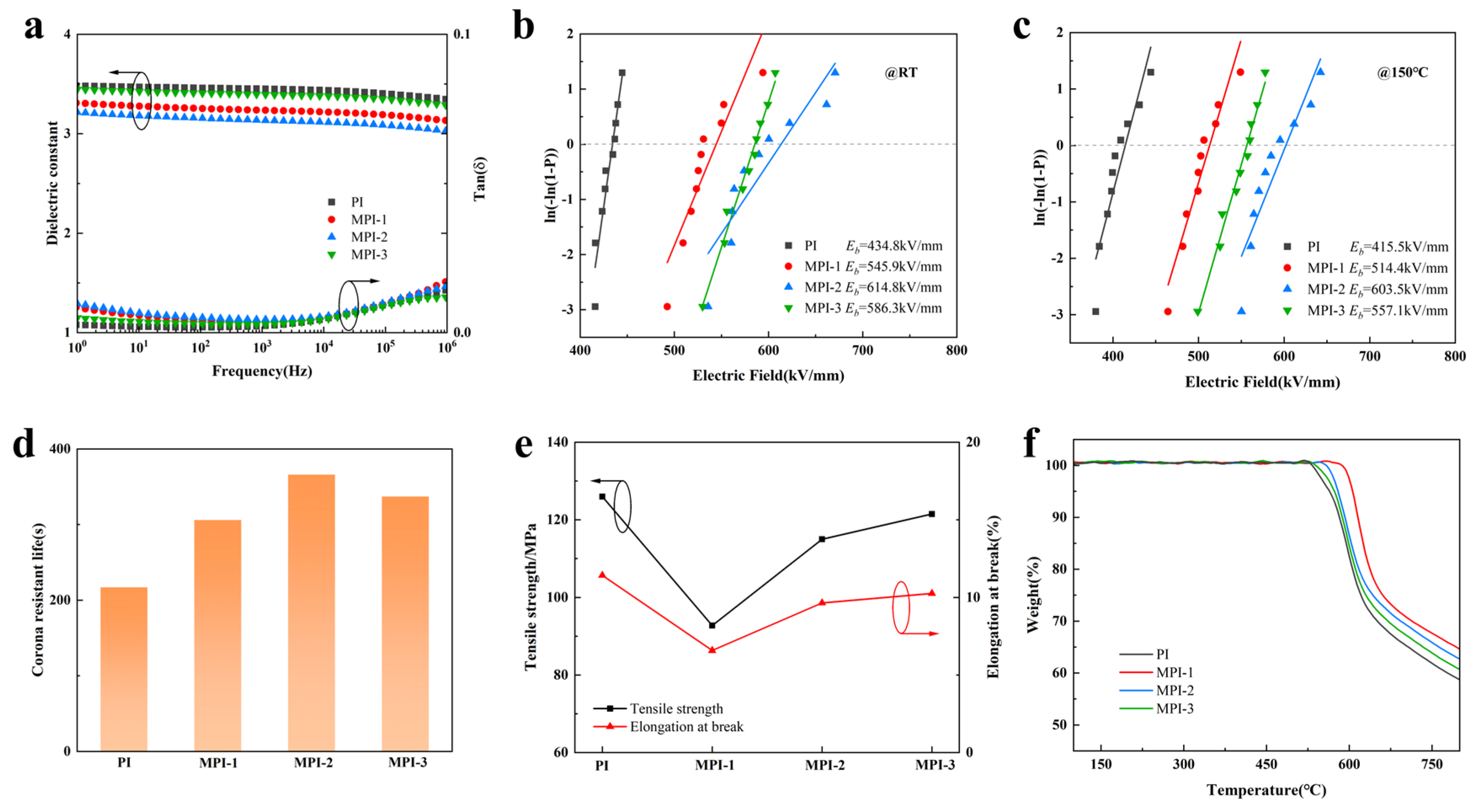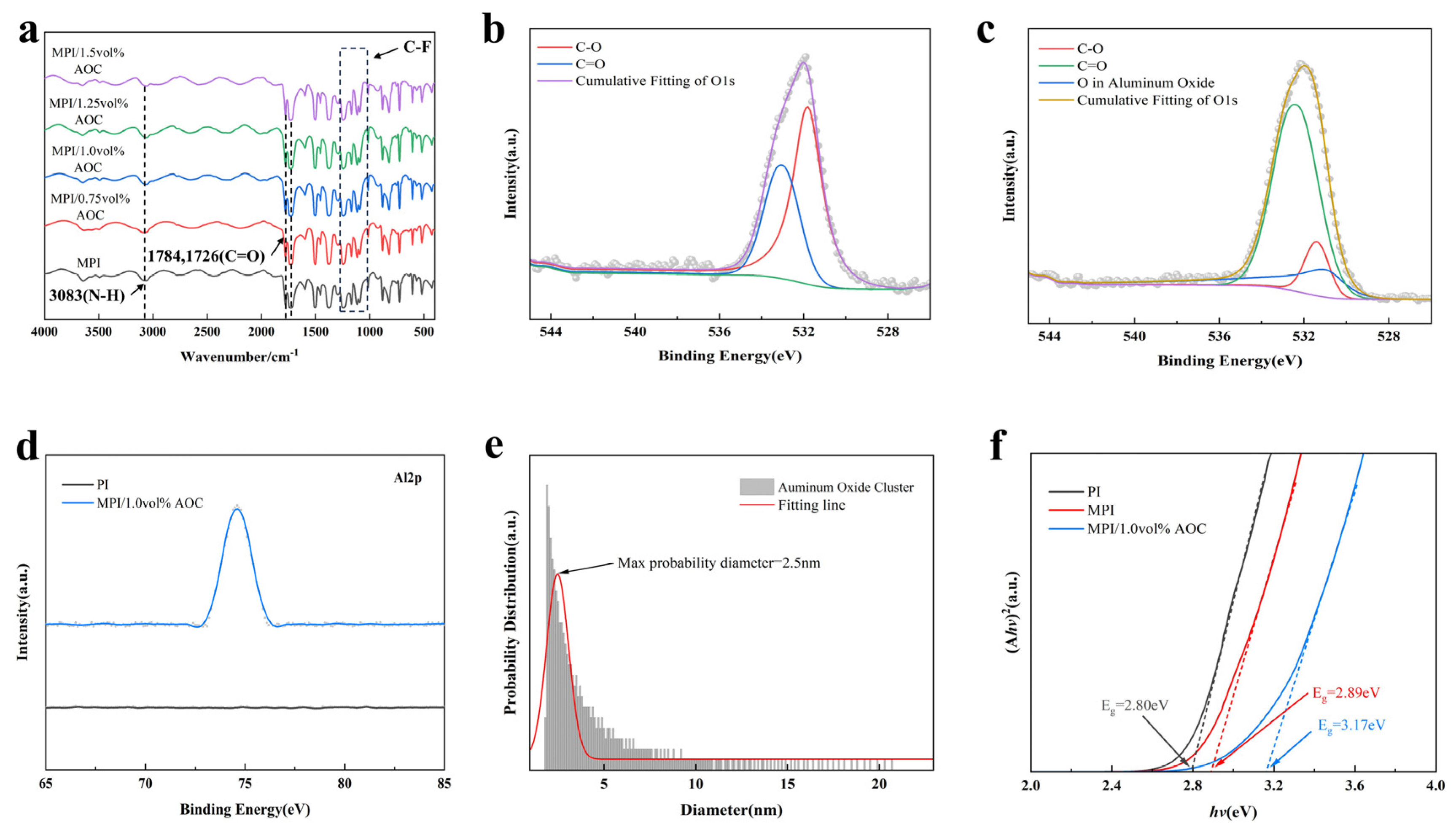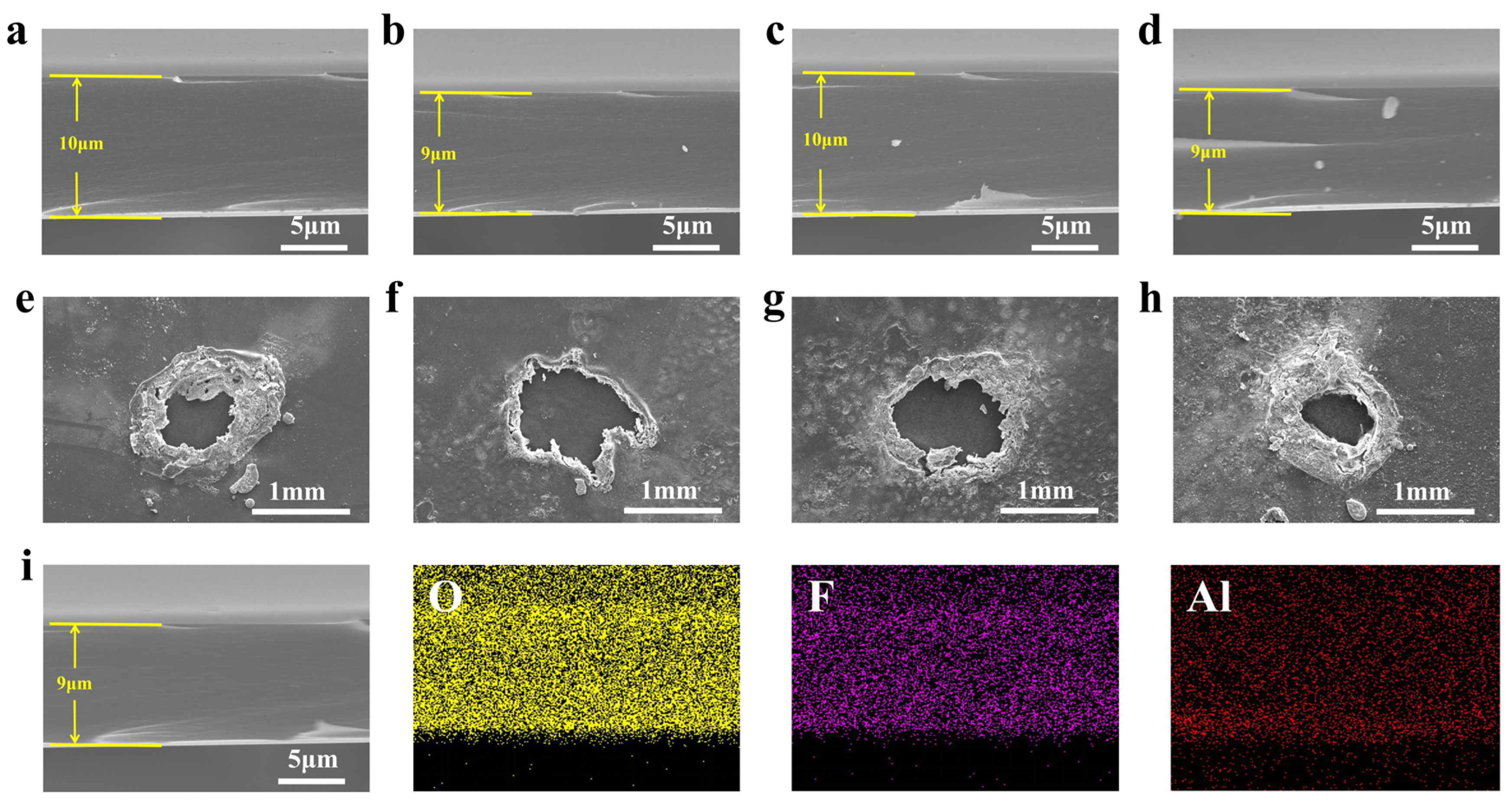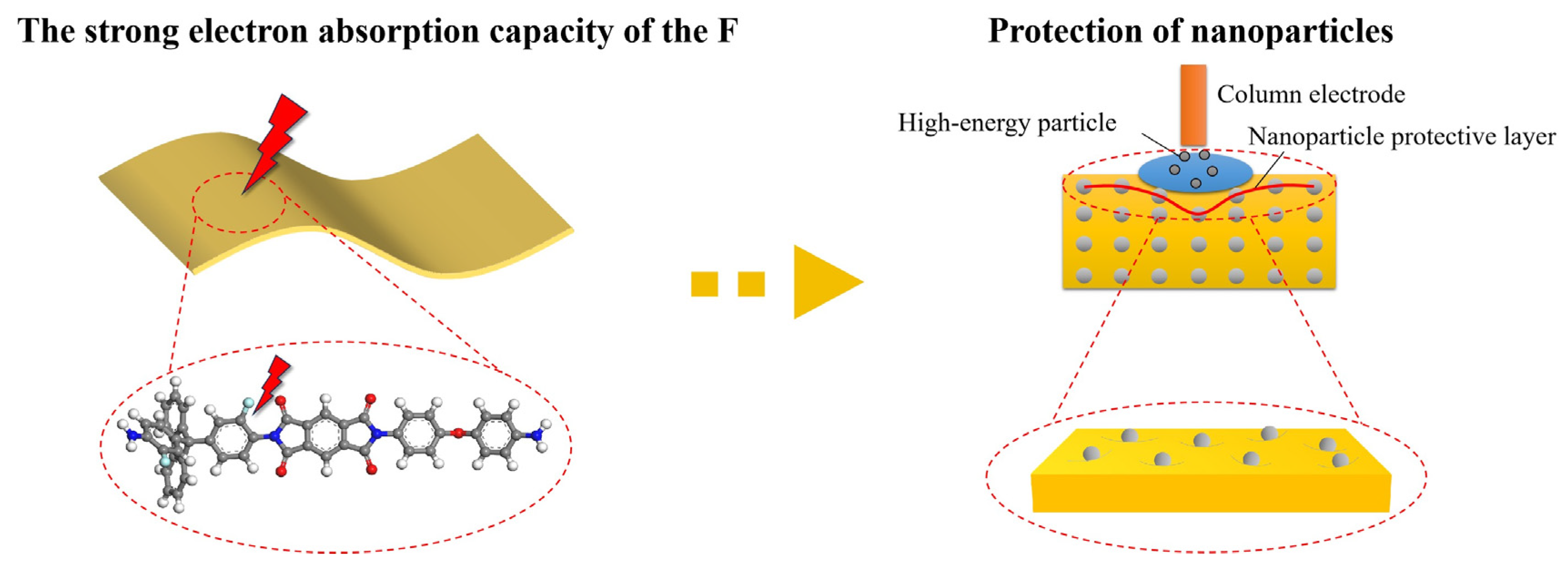Study of the Dielectric and Corona Resistance Properties of PI Films Modified with Fluorene Moiety/Aluminum Sec-Butoxide
Abstract
:1. Introduction
2. Synthesis and Structural Characterization
2.1. Materials
2.2. Preparation of the MPI Composite Films
2.3. Preparation of the MPI/AOC Composite Films
2.4. Characterization
3. Results and Discussion
3.1. Characterization of the MPI Films
3.2. Performance Test of the MPI Films
3.3. Characterization of the MPI/AOC Films
3.4. Performance Test of the MPI/AOC Films
3.5. Analysis of the Corona Resistance Mechanism
4. Conclusions
Supplementary Materials
Author Contributions
Funding
Institutional Review Board Statement
Informed Consent Statement
Data Availability Statement
Conflicts of Interest
References
- Ogbonna, V.E.; Popoola, A.P.I.; Popoola, O.M.; Adeosun, S.O. A review on polyimide reinforced nanocomposites for mechanical, thermal, and electrical insulation application: Challenges and recommendations for future improvement. Polym. Bull. 2020, 79, 663–695. [Google Scholar] [CrossRef]
- Wan, B.; Xiao, M.; Dong, X.; Yang, X.; Zheng, M.; Dang, Z.; Chen, G.; Zha, J. Dynamic Covalent Adaptable Polyimide Hybrid Dielectric Films with Superior Recyclability. Adv. Mater. 2023, 2304175. [Google Scholar] [CrossRef]
- Chen, H.; Li, L.; Zhao, W.; Zhang, X.; Weng, L. Corona Resistance Mechanism of Nano-Modified Polyimide. Polymers 2022, 14, 5469. [Google Scholar] [CrossRef]
- Rumi, A.; Marinelli, J.G.; Barater, D.; Cavallini, A.; Seri, P. The Challenges of Reliable Dielectrics in Modern Aerospace Applications: The Hazard of Corona Resistant Materials. IEEE Trans. Transp. Electrif. 2022, 8, 4646–4653. [Google Scholar] [CrossRef]
- Zhang, M.; Wang, Y.; Jiang, H. New method to prepare corona resistant polyimide composite film. J. Phys. Conf. Ser. 2021, 1948, 012229. [Google Scholar] [CrossRef]
- Qiu, G.; Ma, W.; Wu, L. Low dielectric constant polyimide mixtures fabricated by polyimide matrix and polyimide microsphere fillers. Polym. Int. 2020, 69, 485–491. [Google Scholar] [CrossRef]
- Li, X.; Zhang, B.; Wu, Z.; Liu, Y.; Hu, J.; Zhang, C.; Cao, G.; Zhang, K.; Sun, J.; Liu, X.; et al. Highly flexible, large scaled and electrical insulating polyimide composite paper with nanoscale polyimide fibers. Compos. Commun. 2023, 38, 101463. [Google Scholar] [CrossRef]
- Liu, X.; Ji, T.; Li, N.; Liu, Y.; Yin, J.; Su, B.; Zhao, J.; Li, Y.; Mo, G.; Wu, Z. Preparation of polyimide composites reinforced with oxygen doped boron nitride nano-sheet as multifunctional materials. Mater. Des. 2019, 180, 107963. [Google Scholar] [CrossRef]
- Liu, X.; Zheng, M.; Chen, G.; Dang, Z.; Zha, J. High-temperature polyimide dielectric materials for energy storage: Theory design preparation and properties. Energy Environ. Sci. 2022, 15, 56–81. [Google Scholar] [CrossRef]
- Melfi, M.; Sung, A.M.J.; Bell, S.; Skibinski, G.L. Effect of surge voltage risetime on the insulation of low-voltage machines fed by PWM converters. IEEE Trans. Ind. Appl. 1998, 34, 766–775. [Google Scholar] [CrossRef]
- Peng, W.; Cavallini, A.; Montanari, G.C.; Wu, G. Effect of rise time on PD pulse features under repetitive square wave voltages. IEEE Trans. Dielectr. Electr. Insul. 2013, 20, 245–254. [Google Scholar] [CrossRef]
- Liu, T.; Li, Q.; Dong, G.; Asif, M.; Huang, X.; Wang, Z. Multi-factor model for lifetime prediction of polymers used as insulation material in high frequency electrical equipment. Polym. Test. 2019, 73, 193–199. [Google Scholar] [CrossRef]
- Oyegoke, B.S. Voltage distribution in the stator winding of an induction motor following a voltage surge. Electr. Eng. 2000, 82, 199–205. [Google Scholar] [CrossRef]
- Toru, W.; Hiroki, K.; Naoki, H. Measurement and evaluation of partial discharge inception voltage for enameled rectangular wires under AC voltage. IEEE Trans. Dielectr. Electr. Insul. 2016, 23, 3566–3574. [Google Scholar]
- Hassan, W.; Hussain, G.A.; Mahmood, F.; Ami, S.; Lehtonen, M. Effects of Environmental Factors on Partial Discharge Activity and Estimation of Insulation Lifetime in Electrical Machines. IEEE Access 2020, 8, 108491–108502. [Google Scholar] [CrossRef]
- Yang, Y.; Yin, D.; Zhong, C.; Xiong, R.; Shi, J.; Liu, Z.; Wang, X. Surface morphology and raman analysis of the polyimide film aged under bipolar pulse voltage. Polym. Eng. Sci. 2013, 53, 1536–1541. [Google Scholar] [CrossRef]
- Lin, J.; Wang, Y.; Yang, W.; Lu, H. Balance of mechanical and electrical performance in polyimide/nano titanium dioxide prepared by an in-sol method. J. Appl. Polym. Sci. 2017, 134, 44666. [Google Scholar] [CrossRef]
- Nazir, M.T.; Khalid, A.; Akram, S.; Mishra, P.; Kabir, I.I.; Yeoh, G.H.; Phung, B.T.; Wong, K.L. Electrical tracking, erosion and flammability resistance of high voltage outdoor composite insulation: Research, innovation and future outlook. Mater. Sci. Eng. R Rep. 2023, 156, 100757. [Google Scholar] [CrossRef]
- Lang, F.; Xiang, Y.; Xiao, C.; Li, D. Preparation and properties of ODPA-ODA-SDA polyimide film and its application in corona resistance. Prog. Org. Coat. 2022, 166, 106777. [Google Scholar] [CrossRef]
- Zha, J.; Song, H.; Dang, Z.; Shi, C.; Bai, J. Mechanism analysis of improved corona-resistant characteristic in polyimide/TiO2 nanohybrid films. Appl. Phys. Lett. 2008, 93, 192911. [Google Scholar] [CrossRef]
- Ma, L.; Lei, Q. Enhanced thermal and electrical insulation properties of polyimide films determined via a two-dimensional layered double hydroxide-potassium perfluorooctane sulfonate material. J. Appl. Polym. Sci. 2018, 135, 46528. [Google Scholar] [CrossRef]
- Li, X.; He, T.; Yin, Q.; Qin, Y.; Sun, S.; Yang, J.; Wang, P.; Fan, K.; Liu, X. Fluorinated Al2O3/siloxane modified PI films towards vastly enhanced corona resistance performance. Compos. Part A Appl. Sci. Manuf. 2023, 172, 107613. [Google Scholar] [CrossRef]
- Ma, X.; Liu, L.; He, H.; Weng, L. Effects of interface bonding on the corona resistance of the polyimide/nano-Al2O3 three-layer composite films. High Perform. Polym. 2018, 30, 1240–1246. [Google Scholar] [CrossRef]
- Wu, Z.; Peng, Y.; Guo, Q.; Zhou, H.; Gong, L.; Liu, Z.; Zhang, Q.; Chen, Y. Multilayer heterogeneous dielectric films with simultaneously improved dielectric constant and breakdown strength. Mater. Today Commun. 2022, 32, 103857. [Google Scholar] [CrossRef]
- Lewin, M.; Mey-Marom, A.; Frank, R. Surface free energies of polymeric materials, additives and minerals. Polym. Adv. Technol. 2005, 16, 429–441. [Google Scholar] [CrossRef]
- Chaudhuri, R.G.; Paria, S. Core/shell nanoparticles: Classes, properties, synthesis mechanisms, characterization, and applications. Chem. Rev. 2012, 112, 2373–2433. [Google Scholar] [CrossRef]
- Kafili, G.; Loghman-Estarki, M.R.; Milani, M.; Movahedi, B. The effects of TEOS on the microstructure and phase evolutions of YAG phase by formation of alumina/yttria core-shell structures. J. Am. Ceram. Soc. 2017, 100, 4305–4316. [Google Scholar] [CrossRef]
- Choi, S.-H.; Kim, I.-D.; Hong, J.-M.; Park, K.-H.; Oh, S.-G. Effect of the dispersibility of BaTiO3 nanoparticles in BaTiO3/polyimide composites on the dielectric properties. Mater. Lett. 2007, 61, 2478–2481. [Google Scholar] [CrossRef]
- Xu, G.; Xu, G.; Chang, W.; Wang, H. Fabrication of microsphere-like nano-MoO2 modified with silane coupling agent KH550. Mater. Res. Express 2019, 6, 115087. [Google Scholar] [CrossRef]
- Guo, R.; Luo, H.; Yan, M.; Zhou, X.; Zhou, K.; Zhang, D. Significantly enhanced breakdown strength and energy density in sandwich-structured nanocomposites with low-level BaTiO3 nanowires. Nano Energy 2021, 79, 105412. [Google Scholar] [CrossRef]
- Luo, H.; Zhang, D.; Jiang, C.; Yuan, X.; Chen, C.; Zhou, K. Improved Dielectric Properties and Energy Storage Density of Poly(vinylidene fluoride-co-hexafluoropropylene) Nanocomposite with Hydantoin Epoxy Resin Coated BaTiO3. ACS Appl. Mater. Interfaces 2015, 7, 8061–8069. [Google Scholar] [CrossRef] [PubMed]
- Peng, X.; Liu, H.; Zhu, Z.; Xu, T.; Zhou, G.; Zhou, W.; Bai, J.; Hou, H.; Peng, X. Molecular engineering of a polyimide copolymer enables excellent dielectric and energy storage performance. New J. Chem. 2023, 47, 9564–9568. [Google Scholar] [CrossRef]
- Shi, L.; Bao, F.; Liu, Y.; Li, H.; Zhu, T.; Liu, H.; Yu, J.; Qiao, Y.; Zhu, C.; Jian, X. Design and Synthesis of Low Dielectric Poly(aryl ether ketone) from Incorporation Bulky Fluorene Groups and Regular Hydroquinone Structure. Langmuir 2023, 39, 11439–11447. [Google Scholar] [CrossRef] [PubMed]
- Liu, B.; Long, J.; Chen, L.; Xiao, X.; Lin, X.; Wang, Y. Semi-aromatic polyamides containing fluorenyl pendent toward excellent thermal stability, mechanical properties and dielectric performance. Polymer 2021, 224, 123757. [Google Scholar] [CrossRef]
- Li, Y.; Chu, Y.; Fang, R.; Ding, S.; Wang, Y.; Shen, Y.; Zheng, A. Synthesis and memory characteristics of polyimides containing noncoplanar aryl pendant groups. Polymer 2012, 53, 229–240. [Google Scholar] [CrossRef]
- Yang, X.; Li, W.; Qiao, Y.; Zhang, Y.; He, J.; Fei, W. High energy-storage density of lead-free (Sr1-1.5xBix) Ti0.99Mn0.01O3 thin films induced by Bi3+–VSr dipolar defects. Phys. Chem. Chem. Phys. 2019, 21, 16359–16366. [Google Scholar] [CrossRef] [PubMed]
- Zhang, Y.; Qiao, Y.; Yang, Y.; Fei, W. High energy storage density achieved in Bi3+-Li+ co-doped SrTi0.99Mn0.01O3 thin film via ionic pair doping-engineering. J. Eur. Ceram. Soc. 2020, 40, 706–711. [Google Scholar]
- Binz, S.M.; Hupalo, M.; Tringides, M.C. Quantum size effect dependent critical size cluster and finite size effects. J. Appl. Phys. 2009, 105, 094307. [Google Scholar] [CrossRef]
- Zhao, H.; Yin, J.; Liu, X.; Feng, Y.; Liu, Y.; Li, J.; Li, Y.; Yue, D.; Zhu, C. Effect of 2-D BN on enhanced corona-resistant characteristic of PI/AlN+BN composite investigated by quasi-in-situ technology. Polym. Test. 2020, 84, 106394. [Google Scholar] [CrossRef]
- Sun, L.; Shi, Z.; He, B.; Wang, H.; Liu, S.; Huang, M.; Shi, J.; Dastan, D.; Wang, H. Asymmetric trilayer all-polymer dielectric composites with simultaneous high efficiency and high energy density: A novel design targeting advanced energy storage capacitors. Adv. Funct. Mater. 2021, 31, 2100280. [Google Scholar] [CrossRef]
- Zhou, L.; Wu, G.; Bo, G.; Zhou, K.; Liu, J.; Cao, K.J.; Zhou, L.J. Study on charge transport mechanism and space charge characteristics of polyimide films. IEEE Trans. Dielectr. Electr. Insul. 2009, 16, 1143–1149. [Google Scholar] [CrossRef]
- Zhao, W.; Chen, H.; Fan, Y.; Cui, W. The influences of different size SiO2 nanoparticles on dielectric properties and corona resistance of epoxy composites. Polym. Adv. Technol. 2020, 31, 3070–3078. [Google Scholar] [CrossRef]
- Cheng, Y.; Yu, G. The Research of Interface Microdomain and Corona-Resistance Characteristics of Micro-Nano-ZnO/LDPE. Polymers 2020, 12, 563. [Google Scholar] [CrossRef] [PubMed]







Disclaimer/Publisher’s Note: The statements, opinions and data contained in all publications are solely those of the individual author(s) and contributor(s) and not of MDPI and/or the editor(s). MDPI and/or the editor(s) disclaim responsibility for any injury to people or property resulting from any ideas, methods, instructions or products referred to in the content. |
© 2024 by the authors. Licensee MDPI, Basel, Switzerland. This article is an open access article distributed under the terms and conditions of the Creative Commons Attribution (CC BY) license (https://creativecommons.org/licenses/by/4.0/).
Share and Cite
Zhang, C.; Liu, Z.; Tang, C.; Zhang, T.; Zhang, Y.; Zhang, Y.; Chi, Q. Study of the Dielectric and Corona Resistance Properties of PI Films Modified with Fluorene Moiety/Aluminum Sec-Butoxide. Polymers 2024, 16, 767. https://doi.org/10.3390/polym16060767
Zhang C, Liu Z, Tang C, Zhang T, Zhang Y, Zhang Y, Chi Q. Study of the Dielectric and Corona Resistance Properties of PI Films Modified with Fluorene Moiety/Aluminum Sec-Butoxide. Polymers. 2024; 16(6):767. https://doi.org/10.3390/polym16060767
Chicago/Turabian StyleZhang, Changhai, Ziyang Liu, Chao Tang, Tiandong Zhang, Yue Zhang, Yongquan Zhang, and Qingguo Chi. 2024. "Study of the Dielectric and Corona Resistance Properties of PI Films Modified with Fluorene Moiety/Aluminum Sec-Butoxide" Polymers 16, no. 6: 767. https://doi.org/10.3390/polym16060767



